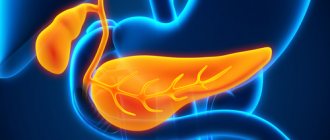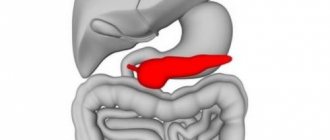Acute pancreatitis
Inflammatory damage to the pancreas, which takes an acute form, is called acute pancreatitis.
Causes
About 70% of cases of acute pancreatitis are associated with drinking alcohol and alcohol poisoning.
Other reasons causing the development of the disease:
- Poor nutrition (fatty foods, overeating);
- Cholelithiasis;
- Heredity;
- Damage to the pancreas (surgery, accident);
- Taking medications in toxic doses;
- Endocrine diseases;
- Infections (hepatitis virus, mycoplasmosis).
Symptoms
The main symptom indicating acute pancreatitis is “boring” pain. It begins in the epigastric zone, hypochondrium (right and left), can take on a encircling character, involving the back, lower and lateral areas of the abdomen.
There are other manifestations:
- Frequent vomiting, causing dehydration;
- Dry mouth, belching;
- Increased body temperature (can reach 40 °C);
- Cardiopalmus;
- Drop in blood pressure;
- Bloating and tenderness of the abdomen;
- Sudden weight loss;
- Diarrhea.
Diagnostic methods
Detection of acute pancreatitis is a difficult task, especially if the disease is in its early stages.
The diagnostic complex consists of the following studies and analyses:
- General blood analysis. Allows you to find signs of the inflammatory process (for example, an increase in the number of leukocytes);
- Blood chemistry. Establishes an excessive concentration of the amylase enzyme (indicates the development of the disease);
- Ultrasound of the abdominal cavity. Detects changes in the pancreas and nearby organs. If the cause of the disease is gallstones, ultrasound helps determine their location;
- Analysis of urine. Detects amylase in urine, confirming the presence of pancreatitis in the patient;
- EGDS. Evaluates the degree of involvement of the stomach in the inflammatory process.
Find out more: Pancreatitis - causes, symptoms, diet, as well as modern and traditional methods of treatment
Eliminate Weakness
You can return to normal health only through competent treatment. An acute pancreatic attack can be treated exclusively in a hospital. In surgical treatment, droppers and intravenous administration of medications are used. Doctors in the hospital pursue several goals:
- stop the necrotic-erosive process;
- relieve pain and inflammation;
- cleanse the body of pancreatic and bile toxins.
When discharging a patient from the hospital, the attending physician will recommend a course of medication for outpatient treatment. Home therapy includes a strict diet and taking medications and vitamin complexes designed to normalize fermentation and reduce symptoms such as weakness or nausea after eating.
Periodically you need to visit your doctor to adjust your medication and undergo a follow-up examination.
To restore the pancreas and improve the tone of the body, it is recommended to take a health course in a medical sanatorium specializing in diseases of the gastrointestinal tract.
Chronic pancreatitis
The development of chronic pancreatitis occurs as a result of a protracted inflammatory process occurring in the pancreas. Men over 40 are most susceptible to the disease, but in recent years there has been an increase in cases of chronic pancreatitis in women and younger people.
Causes
The most common reasons are the patient having gallstone disease and excessive consumption of alcoholic beverages.
Symptoms
The pain in chronic pancreatitis is cutting in nature, the patient feels constant compression in the affected area. The intensity of pain increases if the patient does not adhere to a diet, eats fatty foods and carbonated drinks, or drinks alcohol.
Other symptoms of chronic pancreatitis are belching, vomiting, bloating, stool disorders (thick, profuse bowel movements), lack of appetite. Weight loss is also typical, despite maintaining the usual diet.
Diagnostic methods
As part of the diagnosis of chronic pancreatitis, the patient may be prescribed the following studies and tests:
- Blood analysis. With exacerbation of chronic pancreatitis, an increased concentration of leukocytes in the blood is observed, the erythrocyte sedimentation rate increases, and the amylase level increases (also detected in the urine);
- Ultrasound. The enlargement of the gland (full or partial), the conformity of the sizes of the head, tail and body to the norm, the evenness of the contours are assessed;
- CT. Tomography establishes foci of disease and the presence of stones in the ducts.
For what reasons does pancreatitis develop in men?
Pancreatitis can develop in chronic or acute form. The provoking factors for these types of pathology are similar, but in the first case the inflammatory process is the primary disease, and in the second it develops against the background of various diseases of the digestive system and related organs. Acute pancreatitis can be treated and the risk of recurrent attacks can be eliminated. In the chronic form, exacerbation of the pathology will occur simultaneously with the progression of other inflammatory processes.
Pancreatitis statistics by causes
| Cause | % |
| Alcohol abuse | 40% |
| Cholelithiasis | 30% |
| Excess weight and tendency to overeat | 20% |
| Infectious processes, viral diseases, uncontrolled use of medications and injuries to the digestive system | 5% |
| Hereditary predisposition, congenital anomalies and other factors | 5% |
Acute form
The most common cause of acute pancreatitis is gallstone disease. The inflammatory process is provoked by blockage of the bile duct. Bile and gastric juice enter the pancreas tissue. This factor leads to disruption of the functional state of the organ. The gland begins to digest its own tissues. As a result of this process, inflammation develops.
Other causes of the acute form of the disease:
- violation of the diet and consumption of large amounts of junk food (an increase in the functioning of the pancreas leads to an increase in its choleretic and socogon effect);
- progression of infectious processes in the digestive system (inflammation is caused by pathogenic bacteria and viruses);
- injury to the abdomen and digestive organs;
- complications of peptic ulcer;
- uncontrolled use of certain medications;
- alcohol abuse (one of the most common causes);
- consequences of endocrine abnormalities in the body;
- progression of gastritis;
- some consequences of pathologies of the nervous system;
- duodenal dyskinesia.
Chronic appearance
Chronic pancreatitis is a combination of complications of acute pathology and concomitant diseases that provoke a violation of the functional state of the pancreas. The main cause of the disease is inflammatory-dystrophic processes in the body.
Periodic attacks of exacerbation can be accompanied by long-term remissions, but only if the rules of prevention and adequate treatment are followed.
Other causes of the chronic form of the disease:
hereditary factor and autoimmune abnormalities;- progressive stage of cystic fibrosis;
- hyperlipidemia (an abnormality in which the level of lipids in the blood is significantly higher than normal);
- complications of liver pathologies (hepatitis, cirrhosis);
- consequences of hypocalcemia (critical lack of calcium in the body);
- uncontrolled use of drugs with a choleretic effect.
Pancreatic necrosis
Approximately 20% of patients with acute pancreatitis experience a severe course of the disease, against the background of which changes in the pancreatic parenchyma occur that are degenerative and destructive in nature. Pancreatic necrosis is more common at a young age, women are most susceptible to it.
Causes
Pancreatic necrosis can develop due to the following reasons:
- Cholelithiasis, cholecystitis;
- Poor nutrition (abundance of carbohydrates and fats, overeating);
- Complications after surgery;
- Alcohol abuse, which destroys pancreatic tissue;
- A number of infectious diseases (mononucleosis, mumps).
In approximately 10% of patients, the cause of pancreatic necrosis cannot be determined.
Symptoms
The disease is characterized by rapid development and rapid increase in symptoms:
- Sharp pain, concentrated in the upper abdomen and having a girdling character. Pain on palpation of the affected area;
- Repeated vomiting, attacks of nausea, constant dry mouth;
- Formation of cyanotic spots on the abdominal wall, hyperemic facial skin;
- Attacks of tachycardia, persistence of shortness of breath even at rest;
- The patient feels constant anxiety and tension, suffers from chronic weakness.
Diagnostic methods
To diagnose pancreatic necrosis, the same studies and tests are used as for pancreatitis.
Weakness due to pancreatitis
It is quite difficult to differentiate weakness that occurs specifically with pancreatitis. The sensations are similar to other syndromes, such as chronic fatigue. But there are additional signs that usually accompany inflammation of the pancreas.
Pancreatic pathologies lead to systematic intoxication of the body. Therefore, the patient’s condition has the main symptom of poisoning – nausea. This symptom does not go away after gastric lavage. Vomiting or diarrhea that occurs during an exacerbation also does not bring relief. This happens because pancreatic juice poisoning occurs at a deeper level.
Chronic pancreatitis manifests itself in decreased tone and weakness. They become especially noticeable after eating, when a person wants to quickly lie down on the bed, as it begins to get dark before his eyes.
Eating causes heaviness in the epigastric region, bloating in the upper abdomen, as well as a feeling that the food was fatty and plentiful, even after a small, completely dietary portion.
Weakness due to inflammation of the pancreas is often accompanied by a feeling of bitterness in the mouth, dizziness in the morning and lack of appetite.
A sign of intoxication with pancreatic juices can be bluish formations around the navel, indicating the accumulation of enzymes in subcutaneous fat, and periodic aching pain in the hypochondrium.
Pancreas cancer
A rare disease characterized by the formation of malignant cells in the tissues of the pancreas - cancer.
Causes
Factors contributing to the development of pancreatic cancer may include the following:
- Cigarettes. The risk of developing the disease for smokers is approximately twice as high. The factor is characterized by reversibility; timely cessation of cigarettes reduces the risk of cancer;
- Age. People who have crossed the threshold of 60 years are at risk;
- Floor. The predisposition to pancreatic cancer is higher in men than in women. Some doctors attribute this to a lower percentage of women smoking, but the hypothesis has not received evidence;
- Obesity. Excess weight favors the development of pancreatic malignancy;
- Chronic diseases. Among them, pancreatitis and diabetes mellitus pose the greatest threat;
- Unhealthy eating. The risk of cancer increases if a person's diet contains excess amounts of animal fats and simple carbohydrates;
- Genetic factor. Having a family history of pancreatic cancer should be a reason to be more attentive to your health.
Symptoms
Among the main manifestations through which pancreatic cancer makes itself felt are the following:
- Pain sensations concentrated in the upper abdomen and radiating to the back. The pain is acute and girdling in nature;
- Loss of body weight. Weight decreases despite maintaining eating habits;
- Dry mouth, severe thirst;
- Vomiting caused by the compressive effect of tumor formation;
- Jaundice. Yellowing of the skin and mucous membranes is possible. The symptom is associated with a violation of the outflow of bile, sometimes jaundice is accompanied by itching;
- Feeling of heaviness in the area of the right hypochondrium. The symptom is associated with compression of the splenic vein;
- Stool disorders. Lack of enzymes and poor absorption of fats lead to loose, greasy stools characterized by a pungent odor.
Find out more: Pancreatic cancer - causes, symptoms and treatments
Diagnostic methods
After a physical examination of the patient, the doctor may order the following tests and examinations:
- Ultrasound. Ultrasound examination of the abdominal cavity is indicated if jaundice and pain in the upper abdomen occur. Ultrasound can detect tumor formation;
- CT. Computed tomography reveals even microscopic tumors that go undetected during ultrasound examination;
- Biopsy. An area of the tumor is taken for analysis, the results of which confirm the benign or malignant nature of the tumor;
- Blood analysis. The study is necessary to assess the level of concentration of the CA19-9 antigen in the body;
- To accurately determine the stage at which pancreatic cancer is located, additional tests are prescribed - chest x-ray, liver ultrasound, and others.
The main reasons for deterioration in health
A condition where you often feel dizzy or experience severe weakness in the body can occur for a variety of reasons. For example, this syndrome often affects women with low blood pressure. But it also happens that hypotension becomes a consequence of chronic, low-grade inflammation of the pancreas.
Dizziness accompanied by constant weakness, drowsiness and lethargy is a set of symptoms characteristic of serious diseases:
- pathologies of the cardiovascular system;
- renal failure;
- hepatitis A;
- iron deficiency anemia;
- vegetative-vascular dystonia;
- oncological changes;
- thyroid dysfunction;
- cystic fibrosis (a rare pathology of the pancreas in children);
- protein deficiency (a frequent companion to adherence to a long-term vegetarian diet);
- infectious and viral inflammations.
To exclude such serious causes, you need to undergo examination based on examination and consultation with a therapist. The doctor will give directions for the necessary tests and recommend visiting specialists.
Well-being noticeably worsens if a person leads an incorrect lifestyle:
- eats spicy and fatty foods, eats on the go or dry;
- takes alcohol;
- smokes;
- uncontrollably uses strong medications;
- drinks little clean water (in addition to teas, juices, drinks);
- does not walk in the fresh air;
- leads a sedentary lifestyle;
- doesn't get enough sleep.
Stress, anxiety, and overwork (mental, physical, emotional) can result in significant general weakness. Women and teenagers suffer from dizziness during periods of hormonal surges.
Also, this condition is typical for people who fanatically adhere to a diet not for medicinal purposes, but to quickly lose weight. A lack of important elements and vitamins in the diet leads to depletion of the body and triggers pathological processes in the internal organs.
Pancreatic cyst
A bubble of fluid localized in the pancreatic parenchyma or nearby tissues is called a cyst.
Causes
Pancreatic cysts can be acquired or congenital. Congenital formations are associated with pathologies of tissue development.
Acquired cysts appear due to the following reasons:
- Damage to the pancreas (surgery, accident);
- Chronic or acute pancreatitis;
- Benign tumor;
- Malignant tumor;
- Parasitic infection;
- Excessive concentration of cholesterol in the blood.
Factors favoring the formation of cysts are overeating, large amounts of fatty foods, excessive alcohol consumption, chronic stress.
Symptoms
Symptoms of a pancreatic cyst are directly related to the location and size of the cavity. Signs of the disease may be absent if the size of the formation does not exceed 2 cm.
Larger capsules make themselves known by the following manifestations:
- Painful sensations arising in the area of the left or right hypochondrium. The pain can spread to the navel area and radiate under the shoulder blade. In some cases, the pain takes on a girdling character. The intensity is determined by the onset of complications;
- A compaction that forms in the abdominal cavity, which is easily detected by palpation. The swelling gradually increases in size;
- Jaundice, which becomes the result of compression of nearby organs and deterioration of the outflow of bile;
- Indigestion, nausea and vomiting, alternating constipation and diarrhea;
- Change in color of urine and stool;
- Rapid weight loss associated with intestinal dysfunction;
- Constant feeling of weakness and malaise.
If an infection is attached to the cyst, symptoms include fever, chills, headaches and muscle pain.
Diagnostic methods
Diagnosis of a pancreatic cyst begins with palpation, which reveals a bulge located in the upper abdomen.
The following diagnostic tools are also used:
- Ultrasound. The study reveals the presence of a neoplasm with reduced echogenicity, characterized by smooth contours and rounded shapes;
- Endoscopic ultrasound. Diagnoses the cyst and establishes its nature, on which treatment depends;
- X-ray using contrast agents. Determines the displacement of the stomach caused by the cyst;
- CT. Differentiates between false and true cysts.
Diabetes
The development of diabetes mellitus in a patient is caused by a disruption in the production of insulin by the pancreas and the accumulation of sugar in the blood.
Causes
Genetic predisposition is considered the main factor responsible for the development of diabetes in humans.
The following reasons are also possible:
- Obesity. Individuals with a genetic predisposition to diabetes should primarily control their weight;
- Diseases and damage to the pancreas;
- Emotional stress, state of chronic stress;
- Viral infections (flu, rubella);
- Age. Elderly people are most susceptible to the disease.
Symptoms
Diabetes mellitus can manifest itself in the following manifestations:
- Frequent urination;
- Constant feeling of hunger;
- Sudden weight loss (if it cannot be explained by dietary restrictions);
- Increased dryness of the skin, itching;
- Numbness in the legs and arms;
- Vomiting, nausea;
- Pain in the abdominal area;
- Deterioration of vision;
- Susceptibility to infections, poor wound healing.
Diagnostics
To diagnose diabetes, the doctor performs a sugar test, a blood glucose test, and a urine test. If necessary, other diagnostic methods are used.
Diseases of the pancreas pose a threat to the life and health of the patient and are fraught with dangerous complications. If you notice any of the above symptoms, you should definitely visit a doctor.
Author of the article:
Gorshenina Elena Ivanovna |
Gastroenterologist Education: Diploma in General Medicine received from the Russian State Medical University named after. N. I. Pirogova (2005). Postgraduate course in the specialty "Gastroenterology" - educational and scientific medical ]Our authors[/anchor]











